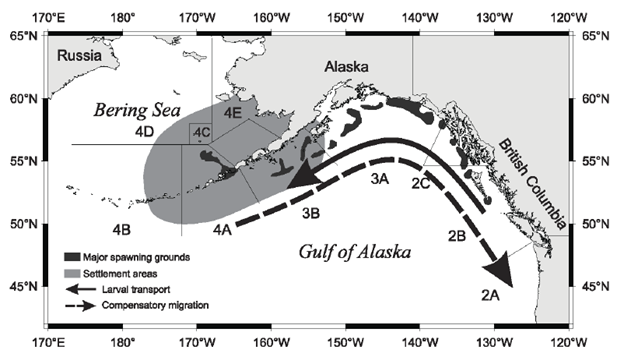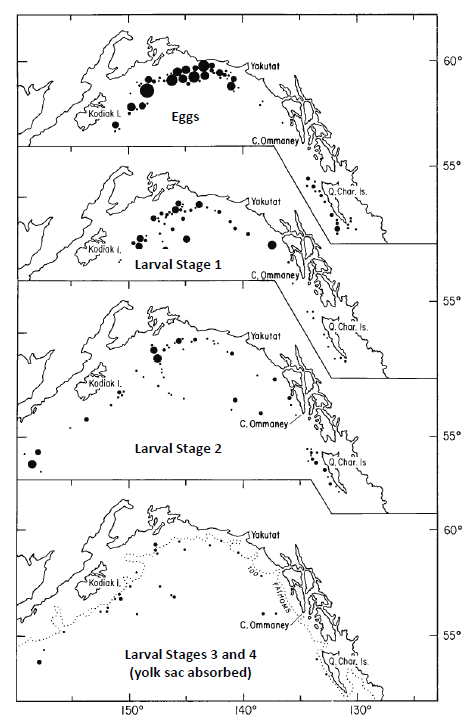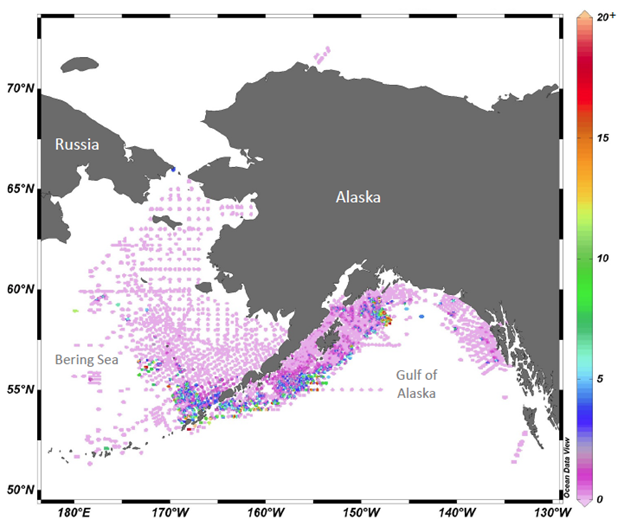Once spawned, Pacific halibut embryos and larvae spend an estimated six months as pelagic organisms before settling in shallow nursery areas as early juveniles. During the first six months of life, a larval Pacific halibut is highly vulnerable to predation, and is dependent on favorable environmental conditions, as well as availability of prey once the yolk sac has been fully absorbed at about two months of age. During this life stage, the larvae are transported by the prevailing ocean currents away from the spawning grounds, westward in the Gulf of Alaska (GOA), and north and northwestward in the Bering Sea (Figure 1). Ultimately, the successful larvae are transported inshore for settlement in shallow nursery areas. A broader conceptual model of larval Pacific halibut movement in the North Pacific Ocean was recently generated (Carpi et al. ,2021).

Figure 1. Drift and counter-migration routes of young Pacific halibut in the Gulf of Alaska.
Over a period of several years in the late 1920s to the early 1930s, the IPHC surveyed the GOA and found that Pacific halibut embryos occurred in large numbers in the central and western GOA, in moderate numbers off Haida Gwaii (formerly Queen Charlotte Is.), and in very small numbers in the eastern GOA (Fig. 2). Larval Pacific halibut were found in decreasing numbers as they passed through the various larval stages, suggesting wide-spread mortality and dispersal as the larvae developed (Thompson and Van Cleve, 1936).

Figure 2. Distribution of Pacific halibut embryos and larvae as reported by Thompson and Van Cleve (1936) and reproduced in Skud (1977).
Since the early 1980s, Pacific halibut larval occurrence data have been collected by the National Oceanic and Atmospheric Administration (NOAA) during ichthyoplankton surveys. These surveys span the GOA, and the Bering Sea/Aleutian Islands (in U.S. waters), but do not include British Columbia waters. Larval Pacific halibut have been found primarily in the central and western GOA, and southern Bering Sea edge, and to a lesser extent, further north and west in the Bering Sea (Fig. 3). Earlier stage larvae that have not yet fully consumed their yolk sac tend to occur at depths several hundred meters deep and offshore. Once the yolk sac has been consumed, the larvae must feed and begin searching for food items. Larval Pacific halibut at this age are able to manipulate their vertical position in the water column and are found closer to the surface where other planktonic organisms are found.

Figure 3. Distribution of Pacific halibut larvae (catch/10 m2) caught during NOAA ichthyoplankton surveys 1972-2015. Figure generated using Ocean Data View software.
Pelagic larval dispersal and connectivity between the GOA and the Bering sea basins was recently investigated at the IPHC using a biophysical larval transport model (Sadorus et al., 2021). The results from this study indicated that the Aleutian Islands constrain connectivity between the GOA and the Bering sea, but that large island passes serve as pathways between these two ocean basins. The modeling work predicted that the degree of larval connectivity between the GOA and the Bering sea is influenced by the spawning location. It was estimated that up to 50-60% of simulated Pacific halibut larvae originating from spawning sites in the western portion of the GOA can reach the Bering sea, with progressively fewer larvae reaching this ocean basin with increasing distance from spawning grounds further east in the Gulf of Alaska. These observations support the hypothesis that eastern Bering Sea nurseries might be composed of a mixture of settlers spawned in both ocean basins (Sohn et al. 2016). Also, a large degree of connectivity between eastern and western GOA and between eastern and western Bering sea was estimated. Overall, this study provided evidence for a high degree of connectivity at larval stages between the GOA and the Bering sea. Future work at the IPHC Secretariat will address potential variations in connectivity pathways under different climate scenarios.
References
Carpi, P., Loher, T., Sadorus, L.L, Forsberg, J.E., Webster, R.A., Planas, J.V, Jasonowicz, A., Stewart, I.J, and Hicks, A.C. 2021. Ontogenetic and spawning migration of Pacific halibut: a review. Rev Fish Biol Fisheries. https://doi.org/10.1007/s11160-021-09672-w
Sadorus, L.L., Goldstein, E.D., Webster, R.A., Stockhausen, W.T., Planas, J.V., Duffy-Anderson, J.T. (2021) Multiple life-stage connectivity of Pacific halibut (Hippoglossus stenolepis) across the Bering Sea and Gulf of Alaska. Fish. Oceanogr. Vol. 30(2):174-193. doi.org/10.1111/fog.12512
Sohn, D., Ciannelli, L., & Duffy-Anderson, J. T. (2016). Distribution of early life Pacific halibut and comparison with Greenland halibut in the eastern Bering Sea. Journal of Sea Research, 107, 31–42. https:// doi.org/10.1016/j.seares.2015.09.001
Skud, B. E. 1977. Drift, migration, and intermingling of Pacific halibut stocks. Int. Pac. Halibut Comm. Sci. Rep. 63.
Thompson, W. F. and Van Cleve, R. 1936. Life history of the Pacific halibut. Rep. of the Int. Fish. Comm. No. 9. 184 p.
